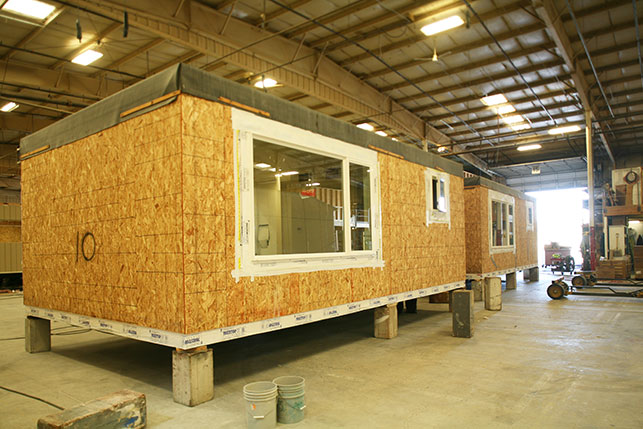
Kah San Chako Haws - Green

The Kah San Chako Haws Studio during construction in the weather-proof factory
Kah San Chako Haws will be LEED Gold.
Following are some green design elements specific to Kah San Chako Haws. Not all items in the LEED Gold designation are listed. Please refer to Green Design for Modular for other green elements in Kah San Chako Haws that are applicable for all modular projects.
Site Location. the site for Kah San Chako Haws was carefully chosen to be in an urban renewal area and a location that reduces fuel consumption and reduces urban sprawl – residents don’t need a car to commute to work, get to school, to shop or to find entertainment.
• The site is an urban infill site, replacing a single family house with 9 living units.
• The site is 4 minutes from a MAX lightrail station and also is on a frequent bus route.
• The site has no parking and a large amount of bike parking for residents, because, well, a resident doesn't need a car.
Water. The site is designed to conserve water.
• The Site has no irrigation – the plantings are indigenous to the Portland region.
• Stormwater from the site is managed on site.
Energy. Reducing energy use on site was a primary goal of Kah San Chako Haws.
• Super insulated walls - R26, blow-in closed cell foam insulation.
• Unit design maximized passive cooling and reduced mechanical air with cross ventilation and siting to maximize ventilation with prevailing winds.
• HRV heat exchange units were used to recycle heat from bathroom showers in one bedroom units.
• Mini-split heat pumps were used to minimize energy use for heating in studio apartments.
Healthy Building. All materials that were used were low or No-VOC, and were selected to support a high level of indoor air quality.
Next Steps. A goal of Kah San Chako Haws was to determine ways to make affordable housing even greener and to keep all green elements in affordable housing project budgets. Our design team analyzed the completed project and interviewed residents to determine best practices and get suggestions and recommendations for future affordable housing projects. We continually look for ways to reduce energy and water consumption and make buildings greener.
Some of the recommendations:
• Affordable housing residents are on fixed incomes - a continuing effort to look for ways to reduce residents' electric bills is recommended.
• Encourage US manufacturers to provide more compact and efficient appliances.
• Encourage HVAC equipment manufacturers to provide more compact and efficient heating for apartments.
• Make solar water heating more affordable for affordable housing projects.
• Make photovoltaics affordable for affordable housing projects for on-site electrical energy production.
Reduce electrical consumption for water heating, laundry equipment, dishwashing.
Achieving high LEED ratings for affordable housing has been hampered by cost considerations - costs for Green non-passive elements are many times targets of value engineering just before construction starts, despite the life-cycle arguments. Kah San Chako Haws was a good step towards making affordable housing greener, and most importantly, set the stage for future affordable housing projects achieving LEED Platinum.
< Home
< Architecture
Wind Mountain,
Columbia Gorge,
Washington

< Kah San Chako Haws
< Kah San Two
< Kah San One
Kah San Process
> Kah San Team
< Kah San Studio
Kah San Green
STUART EMMONS
CONTACT